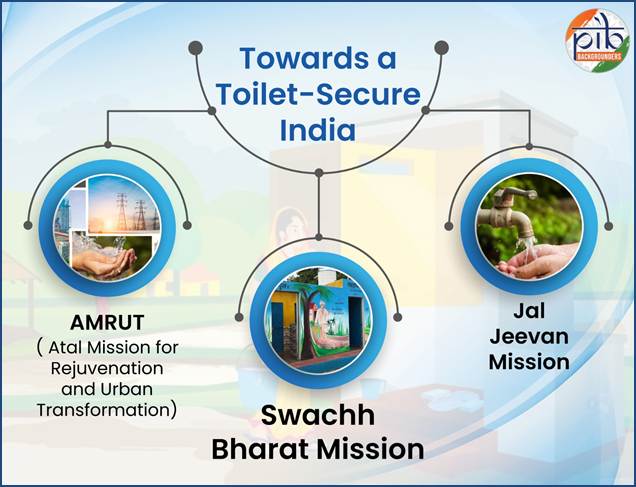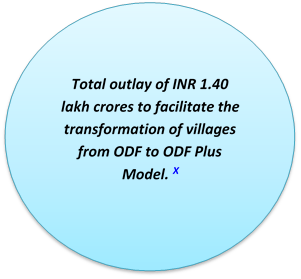Waste to Wellness: India’s Sanitation Journey
Waste to Wellness: India’s Sanitation Journey
Key Takeaways
Overview
Access to safe toilets and proper sanitation is essential for public health, dignity, and environmental sustainability. Improved sanitation reduces waterborne diseases, enhances productivity, and safeguards the environment. It also empowers women and children by providing safety, privacy, and better educational opportunities. In today’s era of climate change, rapid urban expansion, and persistent inequality, secure sanitation continues to be a foundation for human dignity, community well-being, and sustainable progress.
World Toilet Day
World Toilet Day is observed every year on 19 November to raise awareness about the global sanitation crisis and the importance of safe toilets for all. It was officially designated as a United Nations observance in 2013. It highlights toilets as vital for health, dignity, equality, and sustainability and directly supports Sustainable Development Goal 6: Clean Water and Sanitation, aiming for universal access by 2030.
India’s Swachh Bharat Mission is often highlighted by the UN bodies such as UNICEF as one of the largest sanitation drives globally, showcasing how national action can contribute to global goals. As World Toilet Day is being observed, India is moving ahead by turning sanitation into a nationwide success story.

Swatch Bharat Mission (SBM): Global Model for Sanitation Reform
The Government of India has launched several landmark initiatives to improve sanitation and hygiene across the country. The Swachh Bharat Mission (SBM), has been the flagship program, aiming to eliminate open defecation and provide universal toilet access in both rural and urban areas.
India has seen a transformation in its sanitation drive since the launch of the Swachh Bharat Mission, which transformed access to toilets and hygiene facilities across rural and urban areas.
The outcomes of SBM Phase I were remarkable: –
Building on these milestones, SBM (Gramin) Phase II focuses on sustaining ODF outcomes and advancing integrated solid and liquid waste management to achieve ‘Sampoorn Swachhata’.
Phase II of SBM (Gramin) was introduced in 2020 to guarantee universal access to household toilets and effective waste management, with the objective of transforming villages into ODF Plus Models. Its key objective is to sustain the ODF status of villages and to improve the levels of cleanliness in rural areas through solid and liquid waste management activities, making all villages ODF Plus Model, which includes ODF Sustainability, Solid and Liquid Waste Management, and Visual Cleanliness.

ODF Plus Village
An ODF Plus village is defined as a village which sustains its Open Defecation Free (ODF) Status, ensures solid and liquid waste management and is visually clean. There are 3 progressive stages of ODF Plus villages:
India’s progress in sanitation under the Swachh Bharat Mission reflects a clear shift from access to sustainability. In rural areas, villages have steadily advanced from being declared open defecation free to achieving ODF Plus and ODF Plus Model status, showing strong community participation in maintaining facilities. Urban centers, meanwhile, have surpassed targets for household and public toilet construction, ensuring that sanitation infrastructure keeps pace with growing populations.
ODF Plus Plus: It refers to an area where there is no open defecation and all toilets are functional and well-maintained, and all faecal sludge and sewage are safely managed and treated without being discharged into open drains or water bodies.
Rural Sanitation (SBM-Gramin)
Urban Sanitation (SBM-Urban)
(as on 19.11.2025)
Water and Sanitation Synergy: AMRUT & Jal Jeevan Mission
Complementary schemes such as Atal Mission for Rejuvenation and Urban Transformation (AMRUT) focus on urban sewerage and drainage, while the Jal Jeevan Mission ensures a reliable water supply to households, strengthening sanitation outcomes. Together, these policies emphasize sustainability, inclusivity, and dignity, making sanitation a cornerstone of public health and development.
(as on 21.08.2025)
Conclusion:
India’s sanitation journey reflects a transformation from addressing open defecation to building sustainable systems of hygiene and waste management. Through initiatives like the Swachh Bharat Mission, AMRUT, and the Jal Jeevan Mission, the country has moved beyond infrastructure creation to ensuring dignity, inclusivity, and long-term cleanliness. With observance of important events like International Toilet Day, these efforts not only strengthen public health but also align with global commitments under Sustainable Development Goal 6, positioning India as a leader in advancing safe sanitation for all.
References:
Department of Drinking Water and Sanitation, Ministry of Jal Shakti:
https://www.pib.gov.in/PressReleasePage.aspx?PRID=2089254
https://sbm.gov.in/sbmgdashboard/statesdashboard.aspx
https://sansad.in/getFile/loksabhaquestions/annex/185/AU4632_lRzPYO.pdf?source=pqals
Ministry of Housing and Urban Affairs:
https://sansad.in/getFile/loksabhaquestions/annex/185/AU4730_ge4vw3.pdf?source=pqals
https://sbmurban.org/storage/app/media/pdf/ODF_Plus_and_ODF_PlusPlus.pdf
Swachh Bharat Mission:
https://swachhbharatmission.ddws.gov.in/
United Nations: